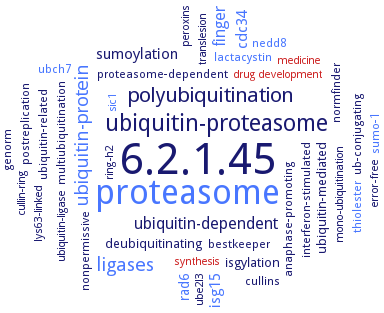6.2.1.45: E1 ubiquitin-activating enzyme
This is an abbreviated version!
For detailed information about E1 ubiquitin-activating enzyme, go to the full flat file.

Word Map on EC 6.2.1.45 
-
6.2.1.45
-
proteasome
-
ubiquitin-proteasome
-
polyubiquitination
-
ligases
-
ubiquitin-protein
-
finger
-
ubiquitin-dependent
-
sumoylation
-
isg15
-
cdc34
-
rad6
-
isgylation
-
ubiquitin-mediated
-
deubiquitinating
-
anaphase-promoting
-
genorm
-
ubiquitin-related
-
ubch7
-
normfinder
-
multiubiquitination
-
sumo-1
-
nonpermissive
-
proteasome-dependent
-
cullins
-
lactacystin
-
bestkeeper
-
ub-conjugating
-
thiolester
-
nedd8
-
postreplication
-
interferon-stimulated
-
peroxins
-
ubiquitin-ligase
-
ring-h2
-
lys63-linked
-
mono-ubiquitination
-
error-free
-
sic1
-
drug development
-
ube2l3
-
translesion
-
synthesis
-
cullin-ring
-
medicine
- 6.2.1.45
- proteasome
-
ubiquitin-proteasome
-
polyubiquitination
- ligases
- ubiquitin-protein
- finger
-
ubiquitin-dependent
-
sumoylation
- isg15
- cdc34
- rad6
-
isgylation
-
ubiquitin-mediated
-
deubiquitinating
-
anaphase-promoting
-
genorm
-
ubiquitin-related
- ubch7
-
normfinder
-
multiubiquitination
- sumo-1
-
nonpermissive
-
proteasome-dependent
-
cullins
- lactacystin
-
bestkeeper
-
ub-conjugating
- thiolester
- nedd8
-
postreplication
-
interferon-stimulated
- peroxins
-
ubiquitin-ligase
-
ring-h2
-
lys63-linked
-
mono-ubiquitination
-
error-free
- sic1
- drug development
- ube2l3
-
translesion
- synthesis
-
cullin-ring
- medicine
Reaction
Synonyms
AtUBA1, AtUBA2, E1, E1 ubiquitin-activating enzyme, HsUba1a, non-canonical ubiquitin activating enzyme, SUMO E1, UB activating enzyme, Ub E1 activating enzyme, Ub-activating enzyme, Ub-activating ligase, Uba1, Uba1/E1, Uba1a, UBA1p, UBA2, UBA5, Uba6, UBA7, UBE1, UBE1DC1, UBE1DC1A, UBE1DC1B, UBE1L, UBE1L2, ubiquitin activating enzyme, ubiquitin activating enzyme 2, ubiquitin activating enzyme E1, ubiquitin activating enzyme E1-like, ubiquitin E1, ubiquitin protein ligase E1, Ubiquitin-activating enzyme, ubiquitin-activating enzyme (E1), ubiquitin-activating enzyme 1, ubiquitin-activating enzyme 5, ubiquitin-activating enzyme 6, ubiquitin-activating enzyme E1, ubiquitin-activating enzyme E1 domain-containing protein 1, ubiquitin-activating enzyme E1-domain containing 1, ubiquitin-activating enzyme, UBE1, ubiquitin-conjugating enzyme, ubiquitin-like modifier-activating enzyme 1, ubiquitin-like modifier-activating enzyme 5, ubiquitin-like modifier-activating enzyme 6, ubiquitin-like modifier-activating enzyme 7 isoform X2


 results (
results ( results (
results ( top
top





